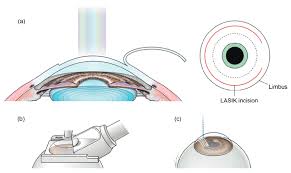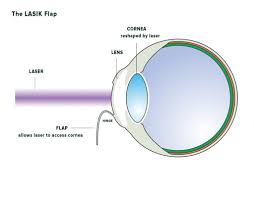Table of Contents
ToggleSick of glasses fogging up or contacts drying out?
LASIK surgery sounds tempting, but what if your prescription is, well, not that bad?
Can LASIK still be a vision game-changer for those with low prescriptions?
This blog cuts through the confusion to reveal the truth about LASIK for low corrections.
We’ll explore what factors determine LASIK eligibility, bust the myth of a “prescription too low,” and even discuss alternative options if LASIK isn’t your perfect match.
Get ready to see the world clearly, on your terms!
Understanding LASIK and Refractive Errors
LASIK, or laser-assisted in situ keratomileusis, is a sophisticated surgical procedure designed to reshape the cornea, correcting common refractive errors such as myopia (nearsightedness), hyperopia (farsightedness), and astigmatism.
By precisely reshaping the corneal surface, LASIK enables light to focus correctly onto the retina, thereby improving vision without the need for corrective eyewear.
The effectiveness of LASIK is largely determined by the degree of refractive error that needs correction.
Traditionally, LASIK has been most effective for moderate to high prescriptions.
However, advancements in technology and surgical techniques have expanded the range of prescriptions that can be safely and effectively treated with LASIK.
Understanding Diopters
LASIK is intended to correct refractive errors, which occur when the eye fails to focus light properly.
These errors are measured in diopters (D), with negative values indicating nearsightedness (myopia) and positive values indicating farsightedness (hyperopia). Astigmatism, a condition causing blurred vision at all distances, is measured independently.
Prescription Ranges for LASIK
LASIK is suitable for correcting various refractive errors within specific prescription ranges:
1. Myopia (Nearsightedness):
Typically, from -0.5 D to -8.0 D, though advancements in technology may extend this range to -12.0 D in certain cases.
2. Hyperopia (Farsightedness):
Up to +6.0 D.
3. Astigmatism:
Up to 6.0 D.
Please note that these are general guidelines. The actual limits can vary based on the technology used by your ophthalmologist and your individual corneal characteristics.
Is Your Prescription Too Low for LASIK?
Determining if your prescription is too low for LASIK isn’t just about the numbers. Here’s why:
– Considering Your Needs: If your vision is adequate for daily activities without glasses or contacts, LASIK might not be necessary. The potential benefits may not outweigh the risks associated with any surgical procedure.
– Weighing the Risks vs. Benefits: Consult with your ophthalmologist to assess your specific situation. They can evaluate your overall suitability and determine if the potential visual improvement justifies undergoing the procedure.
For example, someone with a -1.0 D prescription might have satisfactory uncorrected vision but encounter challenges with specific activities like sports or prefer not to wear glasses for aesthetic reasons. In such cases, LASIK could be a viable option following careful evaluation.
A Look at LASIK Suitability
Although LASIK is highly effective for correcting refractive errors, several factors influence whether you are a suitable candidate for the procedure, even with a low prescription:
- Corneal Thickness: LASIK involves reshaping the cornea by removing a thin layer of tissue. A healthy cornea with sufficient thickness is crucial for safe and successful surgery. If your cornea is too thin, there may not be enough tissue to safely reshape, making you ineligible for LASIK regardless of your prescription strength.
- Corneal Shape: Irregularities in corneal shape can impact the success of LASIK.
- Eye Health: Pre-existing conditions such as dry eye syndrome, keratitis (corneal inflammation), or uncontrolled glaucoma can heighten surgical risks and potentially disqualify you from LASIK.
- Prescription Stability: Your vision prescription should be stable for at least a year before considering LASIK. Significant changes in prescription can affect the long-term outcomes of the procedure.
- Age: LASIK is generally recommended for individuals over 18 years old when the eyes have fully matured. Prescriptions are more likely to fluctuate in younger individuals.
- Overall Health: General health conditions such as autoimmune diseases or uncontrolled diabetes can impact healing and raise the risk of infection.
Exploring Alternative Vision Correction Options
If LASIK is not suitable for your low prescription, several alternative vision correction methods may be considered:
- PRK (Photorefractive Keratectomy): Similar to LASIK, but involves removing the corneal epithelium entirely before reshaping the cornea. Suitable for individuals with thinner corneas.
- Contact Lenses: Advanced contact lens options, such as orthokeratology (Ortho-K) or daily disposable lenses, can provide clear vision without surgery.
- Glasses: Updated lens technologies and frames offer improved comfort and aesthetics.
- Implantable Collamer Lenses (ICLs): These are tiny lenses that are surgically implanted inside the eye to correct vision. They are an excellent option for individuals with high prescriptions or those who are not suitable candidates for LASIK due to corneal issues.
Consultation with a LASIK Surgeon
To determine if LASIK is right for you, schedule a consultation with a qualified LASIK surgeon.
During this evaluation, the surgeon will assess your eye health, prescription stability, corneal thickness, and overall candidacy for the procedure. They will discuss your goals, expectations, and any alternative treatments that may be more suitable based on your individual circumstances.
The Takeaway: Knowledge Empowers Choice
Understanding the factors that influence LASIK candidacy, including the concept of a “too low” prescription, empowers you to make informed decisions. While a low prescription might not automatically disqualify you, it’s crucial to weigh the potential benefits against the risks and explore alternative vision correction methods if LASIK isn’t the best fit.
Remember, a comprehensive evaluation by a qualified ophthalmologist is vital. They can assess your individual needs, corneal health, and overall suitability for LASIK, guiding you towards the vision correction solution that best suits your lifestyle and goals.
By conducting thorough research, maintaining realistic expectations, and fostering open communication with your doctor, you can unlock a world of clear vision that perfectly complements your unique needs.













